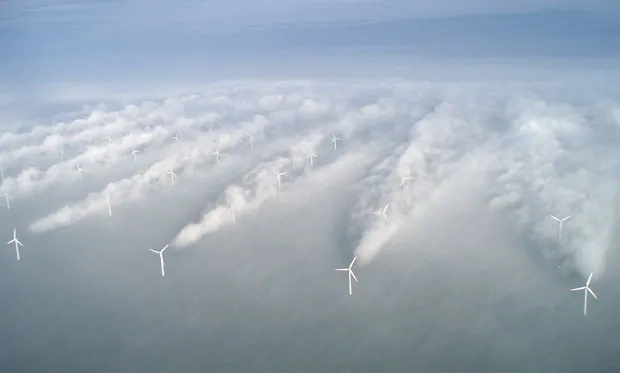Introduction to Wind
Wind power is simple. Wind is used to turn the a turbine, which turns a generator, producing electricity. According to the U.S. Department of Energy, “the terms wind energy and wind power both describe the process by which the wind is used to generate mechanical power or electricity. This mechanical power can then be used for specific tasks (such as grinding grain or pumping water) or a generator can convert this mechanical power into electricity.”
How does a wind turbine precisely work? A good comparison is to think of a blade atop a helicopter. Once wind flows across a turbine the pressure difference on either side of the blade produces an aerodynamic force that causes the blade to rotate.1Office of Energy Efficiency and Renewable Energy. (n.d.). How do wind turbines work? Energy.gov. Retrieved January 24, 2022, from https://www.energy.gov/eere/wind/how-do-wind-turbines-work Power is produced because the rotated turbine is connected to an internal generator. Wind turbines can be located both onshore and offshore. Given the significant wind capacity along bodies of water, the U.S. Department of Energy is currently funding increased offshore wind development in areas such as the Texas Coast, the state with the highest wind power capacity in the country.
Concerns Related to Wind Energy
Wind is a renewable energy source that is often heralded for its cost-effectiveness, sustainability and the fact that it can be installed on existing farms or ranches. Disadvantages that are often discussed include negative visual impact, wildlife impact, noise, remote nature for repairs and service, and safety at sea (for offshore wind). In addition, the United States is heavily reliant on foreign sources for important materials related to wind turbine construction, such as aluminum and rare earth elements. This concern over supply of materials is further discussed on the next topic page on “Could Solar Fill the Gap.”
Renewables Filling the Power Gap
Let’s begin by addressing how we might fill the power gap by examining the capability of renewables, excluding hydroelectric, to fill the gap in the new all-electric world. First, let’s look at the table once more.
2020 Energy Consumption (Quads) Compared to a Potential 2040 Scenario2 https://www.eia.gov/energyexplained/us-energy-facts/, Energy Information Agency (EIA). U.S. Energy Information Administration, Monthly Energy Review, Table 1.3 and 10.1, April 2021, preliminary data. Accessed: 11/22/2021.
| Fuel | 2020* | 2040 | Change |
|---|---|---|---|
| Petroleum | 32.2 | 10.3 | -21.9 |
| Natural Gas | 31.5 | 34.5 | 3 |
| Coal | 9.2 | 9.2 | 0 |
| Nuclear | 8.2 | 8.2 | 0 |
| Hydro-electric | 2.5 | 2.5 | 0 |
| Renewables | 9.1 | 13.6 | 4.5 |
| Total | 92.7** | 78.3 | -14.4 |
U.S. energy consumption by source in 2020, with a potential scenario for 2040. Energy measured in quadrillion BTUs (quads). *Actual numbers reported by EIA may differ between publications as reports of actual consumption are updated. For this study please refer to the April 2021 EIA data. ** Sum of components on EIA publications may vary slightly due to independent rounding.
If renewables (excluding hydro-electric) were to fill the gap, how much total power would they need to provide, measured in quads?
4.5 quads
Incorrect.
28 quads
Correct.
If renewable power filled the gap it would have to provide 28 quads of energy to account for its 2040 energy projection as well as the 14.4-quad gap.
37.1 quads
Incorrect.
We can see from the data below that wind and solar comprise 26% and 11% respectively of our 11.6 quads of renewable energy consumption.

Could Wind Alone Fill the Gap?
The wind power consumed in the United States (2020) is roughly 3 quads per year. Therefore, if wind power was to make up this gap of 14.4 quads alone, there would need to be a generation increase of ~ 500%. Is this possible?
The largest wind turbines implemented in the United States today are currently designed for offshore generation. These turbines have a capacity of 6 MW at Block Island Wind Farm (Massachusetts), but a new Vineyard Wind 1 Farm (offshore Massachusetts) will use 13 MW.3Office of Energy Efficiency and Renewable Energy. (n.d.). Top 10 things you didn’t know about offshore wind energy. Energy.gov. Retrieved January 24, 2022, from https://www.energy.gov/eere/wind/articles/top-10-things-you-didnt-know-about-offshore-wind-energy Let’s split the difference and use 10 MW for turbine power for our planning. Given the wind doesn’t always blow, a good proxy for average run time of a wind turbine on a daily basis is 50%. One turbine running at this efficiency would produce 43,800 MWh (megawatt-hours) of energy in a year (=10 MW x 24 hrs/day x 365 days/yr). Let’s plug that in to some calculations to determine how many more wind turbines we need to fill the gap. Notice we will need to convert between units of energy (quad and MWh).
Conversion: one quad = 293,071,070 MWh
14.4 quads x 293,071,070 MWh/quad = 4,220,223,408 MWh needed to fill the gap
4,220,223,408 MWh / 43,800 MWh/wind turbine = 96,352 wind turbines
Therefore, to satisfy demand, it would take a total of roughly 100,000 additional wind turbines. According to the U.S. Geological Survey, in January of 2021 there were a total of 67,000 wind turbines in the United States. On average 3,000 turbines have been built in the U.S. each year since 2005. But these 10 MW turbines we are considering are typically for offshore. And given wind farms face a number of issues before construction can begin, such as land allocation stipulations and mandatory intense environmental analysis prior to a wind farm being built, we would need to get really busy if we want to try to tackle this challenge. Additionally, other wind power inefficiencies need to be targeted before we begin to rely more heavily on wind in the future. Inefficiencies include: improving transmission to allow enough supply to the grid when the wind doesn’t blow in one location, shaping demand (e.g., smart meters, timing of industrial operations), and increasing storage capacity of the grid.4Michael Graham Richard, P. G. (2020, June 22). Why can’t we generate all our energy from wind power? HowStuffWorks Science. Retrieved January 24, 2022, from https://science.howstuffworks.com/environmental/energy/why-cant-we-generate-all-our-energy-from-wind-power.htm Given we must improve such inefficiencies and find a way to approve and build large-scale wind farms at a fast pace, do you think wind alone can fill the gap?
The Future of Wind Turbine Design to Improve Efficiency and Reliability
Although there are inefficiencies present, the fact that wind power prices have continued to fall leads to an upward trajectory of its use in the future. Additionally, turbine design is constantly being studied and improved to increase both efficiency and reliability of wind power. Such research is currently being conducted at The University of Texas at Austin in their Advanced Power Systems and Control Laboratory, led by Dr. Dongmei Chen. This research targets improvements on inefficiency areas with respect to wind turbines, such as optimizing control of a wind turbine with a variable ratio gearbox for maximum energy capture and prolonged gear life. A variable ratio gearbox allows the turbine to shift sequence when necessary under conditions with varied wind speeds to improve energy harvesting and reduce noise.

The impacts of a variable ratio gearbox are especially important for turbines situated in large wind farms, where they are susceptible to wind speed changes due to the “wind wake effect.” The wake effect is the aggregated influence on the energy production of the wind farm, which results from the changes in wind speed caused by the impact of the turbines on each other.” Additionally, minimizing noise emissions from turbines will result in better public acceptance, especially for residential communities residing near wind farms.5Shaltout, M., & Chen, D. (n.d.). Optimal Control of Wind Turbine Drive Train . Retrieved January 24, 2022, from http://www.apscl.me.utexas.edu/wp-content/uploads/pdf/optimal.pdf6Intelligent Energy Europe. (n.d.). Wind Energy The Facts. Wake effect. Retrieved January 24, 2022, from https://www.wind-energy-the-facts.org/wake-effect-7.html
Career Spotlight: Dr. Dongmei Chen

Academic Background
- PhD from The University of Michigan in 2006
Dr. Dongmei “Maggie” Chen is an Associate Professor in the Walker Department of Mechanical Engineering and holds the Chevron Centennial Fellowship in Engineering No. 2. Dr. Chen’s primary department research areas are in robotics and intelligent mechanical systems, with her current research focused on the application of non-linear control theory to electric vehicles and alternative energy systems such as fuel cells, rechargeable batteries, and integrated wind systems. In 2011 Dr. Chen received a CAREER award from the National Science Foundation related to her research on control of integrated wind turbines and rechargeable battery systems. Prior to joining The University of Texas in 2009 Dr. Chen worked for General Motors’ Fuel Cells Activities Center.